Museum Eye
Published in Issue 5 (Sep/Oct 2007), Reviews, Volume 15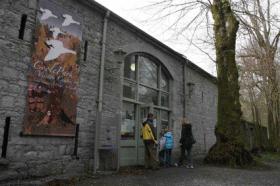
The restored stables that house the visitor centre. Coole Park House itself was demolished in 1942.
Coole Park through the eyes of Me and Nu: granddaughters of Lady Gregory
Coole Park, Gort, Co. Galway
April–September 10am–5pm (6pm in July and August); nature reserve open year-round.
by Marie Bourke
It is always a pleasure to visit Galway to view a new exhibition, in this instance at Coole Park, home to Lady Gregory between 1880 and 1932. Anne Gregory’s book Me and Nu: childhood at Coole (1970) forms the theme of this exhibition. The title refers to two of the three Gregory grandchildren, Catherine (the youngest, called ‘Nu’) and Anne, while Richard was the older brother. These children of Robert and Margaret Gregory were called ‘the chicks’ by their grandmother in her journals, and Anne’s book explores their lives at Coole, where they remained until they went to school.
The Gregorys first came to Coole in the 1770s, and over the years shaped the demesne around the woods and lake,
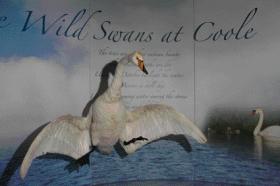
Part of the ‘Wildlife’ display.
and built a large and comfortable house. In time, Coole Park became home to Augusta Gregory (1852–1932), the dramatist, folklorist and co-founder of the Abbey Theatre (with William Butler Yeats and Edward Martyn). This exhibition, in addition to illustrating childhood memories and pastimes, reveals how, in the early twentieth century, Coole was the centre of the Irish literary revival. The Yeats father and sons (John Butler, William and Jack B.), together with George Bernard Shaw, John Millington Synge and Seán O’Casey, amongst others, came to rest, revive and experience the magic of Coole. The initials of these and many other important figures of the cultural renaissance are carved on the ‘autograph tree’ in the grounds of the park. Following Lady Gregory’s death in 1932 the house was sold, and was demolished in 1942.
The courtyard and stables were restored and opened as a visitor centre in 1992. The centre includes a lecture theatre that seats 50 people and attractive tea rooms (which are appropriately illustrated with photographs of the historic house and grounds and with images by local artist Pádraic Reaney). A second carpark was added in 2006. The exhibition is located on two floors of the visitor centre, with the connecting stairs and lift conveniently adjacent to the tea rooms.
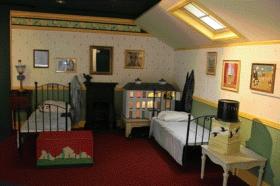
The nursery—the exhibition is presented from the perspective of the Gregory grandchildren
The exhibition is woven around key areas of the house (from the children’s perspective), with the hallway on the ground floor and stairs leading to the nursery, library and drawing-room on the second floor. It is a lively, family-oriented presentation, with each area of the house leading to the next. What strikes the visitor immediately is how child-friendly the layout and design of the exhibition are, with the display panels carefully placed at a child’s eye-level. The labels are clearly written in English and Irish, amplified by colourful illustrations of some of the literary figures. The material culture of the house is revealed through domestic furniture such as hall-stands (replete with hats, walking-sticks and cricket bats), nursery beds, children’s toy-chests, a doll’s house and children’s books. Despite being situated in a corridor-like space, the library contains reading-chairs, lamps and bookcases. (Seán O’Casey once said that Lady Gregory’s loves were books, which were nearest her mind, and trees, which were nearest her heart.) The drawing-room, which is at the heart of the house, recreates Lady Gregory’s favourite space in the corner of the room, where she wrote at her desk framed by great windows. The desk is placed in front of one large window, which is graced by a splendid white marble figure of Andromeda. Among the various objects and paraphernalia on display are her familiar black hat and veil. Items such as these lend an intimate personal atmosphere to the exhibition. The centre also boasts a very fine bust of Lady Gregory by contemporary sculptor John Coll.
The exhibition is well thought out and conceived, and what really brings it to life is the high quality and the clever placing of the visual material. Large screens, well integrated into each of the spaces, narrate the story of the exhibition by means of two child actors who recreate the scenes described in the displays. It quickly becomes evident that Coole Park was central to the story of the Irish literary revival, but this information is conveyed by means of a child-like world, making it easy and enjoyable to understand the key figures and historical developments.
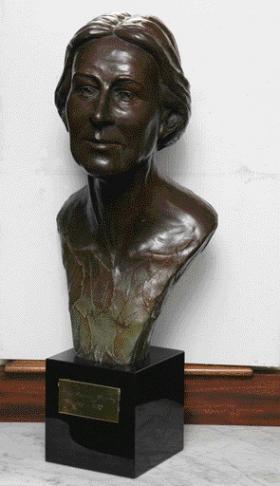
Bust of Lady Augusta Gregory by contemporary sculptor John Coll.
(All images Coole Park Visitor Centre)
Concluding the visit on the top floor is a superb ‘Wildlife’ display. This is a most attractive presentation of the flora and fauna of Coole Park, which is now a nature reserve. I left very impressed by this exhibition and have no hesitation in recommending a visit to Coole Park Visitor Centre and Nature Reserve. Equally impressive are the ‘arts and heritage’ activities (during the winter months outside of the regular season), comprising a proactive programme of lectures, drama workshops, concerts, heritage courses and school events.
There is no doubt that Coole Park’s finest hour was when Lady Gregory was its mistress and, in the words of W. B. Yeats, great figures ‘came like swallows and like swallows went’. Nonetheless, the Friends of Coole and the National Parks and Wildlife Service are to be commended for this centre, and if I had one quibble it would be to enquire why it is not open year-round.
Marie Bourke is Keeper and Head of Education at the National Gallery of Ireland and chairperson of the Irish Museums Association.
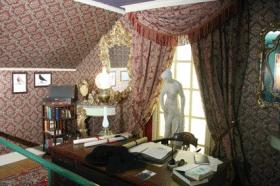
The drawing-room—recreates Lady Gregory’s favourite space in the corner of the room.
















